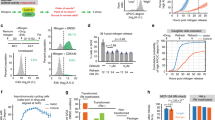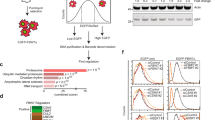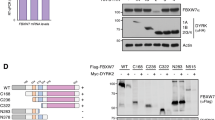Abstract
Fbw7 and Cdh1 are substrate-recognition subunits of the SCF- and APC-type E3 ubiquitin ligases, respectively. There is emerging evidence suggesting that both Fbw7 and Cdh1 function as tumor suppressors by targeting oncoproteins for destruction. Loss of Fbw7, but not Cdh1, is frequently observed in various human tumors. However, it remains largely unknown how Fbw7 mechanistically functions as a tumor suppressor and whether there is a signaling crosstalk between Fbw7 and Cdh1. Here, we report that Fbw7-deficient cells not only display elevated expression levels of SCFFbw7 substrates, including cyclin E, but also have increased expression of various APCCdh1 substrates. We further defined cyclin E as the critical signaling link by which Fbw7 governs APCCdh1 activity, as depletion of cyclin E in Fbw7-deficient cells results in decreased expression of APCCdh1 substrates to levels comparable to those in wild-type (WT) cells. Conversely, ectopic expression of cyclin E recapitulates the aberrant APCCdh1 substrate expression observed in Fbw7-deficient cells. More importantly, 4A-Cdh1 that is resistant to Cdk2/cyclin E-mediated phosphorylation, but not WT-Cdh1, reversed the elevated expression of various APCCdh1 substrates in Fbw7-deficient cells. Overexpression of 4A-Cdh1 also resulted in retarded cell growth and decreased anchorage-independent colony formation. Altogether, we have identified a novel regulatory mechanism by which Fbw7 governs Cdh1 activity in a cyclin E-dependent manner. As a result, loss of Fbw7 can lead to aberrant increase in the expression of both SCFFbw7 and APCCdh1 substrates. Our study provides a better understanding of the tumor suppressor function of Fbw7, and suggests that Cdk2/cyclin E inhibitors could serve as effective therapeutic agents for treating Fbw7-deficient tumors.
Similar content being viewed by others
Log in or create a free account to read this content
Gain free access to this article, as well as selected content from this journal and more on nature.com
or
References
Bakhoum SF, Compton DA . Cancer: CINful centrosomes. Curr Biol 2009; 19:R642–R645.
Bannon JH, Mc Gee MM . Understanding the role of aneuploidy in tumorigenesis. Biochem Soc Trans 2009; 37:910–913.
Schvartzman JM, Sotillo R, Benezra R . Mitotic chromosomal instability and cancer: mouse modelling of the human disease. Nat Rev Cancer 2010; 10:102–115.
Nakayama KI, Nakayama K . Ubiquitin ligases: cell-cycle control and cancer. Nat Rev Cancer 2006; 6:369–381.
Cardozo T, Pagano M . The SCF ubiquitin ligase: insights into a molecular machine. Nat Rev Mol Cell Biol 2004; 5:739–751.
Nakayama KI, Nakayama K . Regulation of the cell cycle by SCF-type ubiquitin ligases. Semin Cell Dev Biol 2005; 16:323–333.
Welcker M, Clurman BE . FBW7 ubiquitin ligase: a tumour suppressor at the crossroads of cell division, growth and differentiation. Nat Rev Cancer 2008; 8:83–93.
Spruck CH, Strohmaier H, Sangfelt O, et al. hCDC4 gene mutations in endometrial cancer. Cancer Res 2002; 62:4535–4539.
Bai C, Sen P, Hofmann K, et al. SKP1 connects cell cycle regulators to the ubiquitin proteolysis machinery through a novel motif, the F-box. Cell 1996; 86:263–274.
Petroski MD, Deshaies RJ . Function and regulation of cullin-RING ubiquitin ligases. Nat Rev Mol Cell Biol 2005; 6:9–20.
Hao B, Oehlmann S, Sowa ME, Harper JW, Pavletich NP . Structure of a Fbw7-Skp1-cyclin E complex: multisite-phosphorylated substrate recognition by SCF ubiquitin ligases. Mol Cell 2007; 26:131–143.
Orlicky S, Tang X, Willems A, Tyers M, Sicheri F . Structural basis for phosphodependent substrate selection and orientation by the SCFCdc4 ubiquitin ligase. Cell 2003; 112:243–256.
Minella AC, Clurman BE . Mechanisms of tumor suppression by the SCF(Fbw7). Cell Cycle 2005; 4:1356–1359.
Akhoondi S, Sun D, von der Lehr N, et al. FBXW7/hCDC4 is a general tumor suppressor in human cancer. Cancer Res 2007; 67:9006–9012.
Enders GH . Cyclins in breast cancer: too much of a good thing. Breast Cancer Res 2002; 4:145–147.
Malyukova A, Dohda T, von der Lehr N, et al. The tumor suppressor gene hCDC4 is frequently mutated in human T-cell acute lymphoblastic leukemia with functional consequences for Notch signaling. Cancer Res 2007; 67:5611–5616.
Strohmaier H, Spruck CH, Kaiser P, Won KA, Sangfelt O, Reed SI . Human F-box protein hCdc4 targets cyclin E for proteolysis and is mutated in a breast cancer cell line. Nature 2001; 413:316–322.
Thompson BJ, Buonamici S, Sulis ML, et al. The SCFFBW7 ubiquitin ligase complex as a tumor suppressor in T cell leukemia. J Exp Med 2007; 204:1825–1835.
O'Neil J, Grim J, Strack P, et al. FBW7 mutations in leukemic cells mediate NOTCH pathway activation and resistance to gamma-secretase inhibitors. J Exp Med 2007; 204:1813–1824.
Onoyama I, Tsunematsu R, Matsumoto A, et al. Conditional inactivation of Fbxw7 impairs cell-cycle exit during T cell differentiation and results in lymphomatogenesis. J Exp Med 2007; 204:2875–2888.
Rajagopalan H, Jallepalli PV, Rago C, et al. Inactivation of hCDC4 can cause chromosomal instability. Nature 2004; 428:77–81.
Minella AC, Swanger J, Bryant E, Welcker M, Hwang H, Clurman BE . p53 and p21 form an inducible barrier that protects cells against cyclin E-cdk2 deregulation. Curr Biol 2002; 12:1817–1827.
Loeb KR, Kostner H, Firpo E, et al. A mouse model for cyclin E-dependent genetic instability and tumorigenesis. Cancer Cell 2005; 8:35–47.
Zhang H . Life without kinase: cyclin E promotes DNA replication licensing and beyond. Mol Cell 2007; 25:175–176.
Keck JM, Summers MK, Tedesco D, et al. Cyclin E overexpression impairs progression through mitosis by inhibiting APC(Cdh1). J Cell Biol 2007; 178:371–385.
Garcia-Higuera I, Manchado E, Dubus P, et al. Genomic stability and tumour suppression by the APC/C cofactor Cdh1. Nat Cell Biol 2008; 10:802–811.
Burton JL, Solomon MJ . D box and KEN box motifs in budding yeast Hsl1p are required for APC-mediated degradation and direct binding to Cdc20p and Cdh1p. Genes Dev 2001; 15:2381–2395.
Pfleger CM, Kirschner MW . The KEN box: an APC recognition signal distinct from the D box targeted by Cdh1. Genes Dev 2000; 14:655–665.
Li M, Zhang P . The function of APC/CCdh1 in cell cycle and beyond. Cell Div 2009; 4:2.
Skaar JR, Pagano M . Cdh1: a master G0/G1 regulator. Nat Cell Biol 2008; 10:755–757.
Wasch R, Engelbert D . Anaphase-promoting complex-dependent proteolysis of cell cycle regulators and genomic instability of cancer cells. Oncogene 2005; 24:1–10.
Wasch R, Robbins JA, Cross FR . The emerging role of APC/CCdh1 in controlling differentiation, genomic stability and tumor suppression. Oncogene 2010; 29:1–10.
Engelbert D, Schnerch D, Baumgarten A, Wasch R . The ubiquitin ligase APC(Cdh1) is required to maintain genome integrity in primary human cells. Oncogene 2008; 27:907–917.
Ross KE, Cohen-Fix O . The role of Cdh1p in maintaining genomic stability in budding yeast. Genetics 2003; 165:489–503.
Wang X, Di K, Zhang X, et al. Id-1 promotes chromosomal instability through modification of APC/C activity during mitosis in response to microtubule disruption. Oncogene 2008; 27:4456–4466.
Shim EH, Johnson L, Noh HL, et al. Expression of the F-box protein SKP2 induces hyperplasia, dysplasia, and low-grade carcinoma in the mouse prostate. Cancer Res 2003; 63:1583–1588.
Gstaiger M, Jordan R, Lim M, et al. Skp2 is oncogenic and overexpressed in human cancers. Proc Natl Acad Sci USA 2001; 98:5043–5048.
Bischoff JR, Anderson L, Zhu Y, et al. A homologue of Drosophila aurora kinase is oncogenic and amplified in human colorectal cancers. EMBO J 1998; 17:3052–3065.
Eckerdt F, Yuan J, Strebhardt K . Polo-like kinases and oncogenesis. Oncogene 2005; 24:267–276.
Liao C, Wang XY, Wei HQ, et al. Altered myelopoiesis and the development of acute myeloid leukemia in transgenic mice overexpressing cyclin A1. Proc Natl Acad Sci USA 2001; 98:6853–6858.
Gao D, Inuzuka H, Tseng A, Chin RY, Toker A, Wei W . Phosphorylation by Akt1 promotes cytoplasmic localization of Skp2 and impairs APCCdh1-mediated Skp2 destruction. Nat Cell Biol 2009; 11:397–408.
Inuzuka H, Tseng A, Gao D, et al. Phosphorylation by casein kinase I promotes the turnover of the Mdm2 oncoprotein via the SCF(beta-TRCP) ubiquitin ligase. Cancer Cell 2010; 18:147–159.
Gao C, Guo H, Downey L, Marroquin C, Wei J, Kuo PC . Osteopontin-dependent CD44v6 expression and cell adhesion in HepG2 cells. Carcinogenesis 2003; 24:1871–1878.
Lukas C, Sorensen CS, Kramer E, et al. Accumulation of cyclin B1 requires E2F and cyclin-A-dependent rearrangement of the anaphase-promoting complex. Nature 1999; 401:815–818.
Hsu JY, Reimann JD, Sorensen CS, Lukas J, Jackson PK . E2F-dependent accumulation of hEmi1 regulates S phase entry by inhibiting APC(Cdh1). Nat Cell Biol 2002; 4:358–366.
Qiao X, Zhang L, Gamper AM, Fujita T, Wan Y . APC/C-Cdh1: from cell cycle to cellular differentiation and genomic integrity. Cell Cycle 2010; 9:3904–3912.
Levine AJ . p53, the cellular gatekeeper for growth and division. Cell 1997; 88:323–331.
Riley T, Sontag E, Chen P, Levine A . Transcriptional control of human p53-regulated genes. Nat Rev Mol Cell Biol 2008; 9:402–412.
Sabatini DM . mTOR and cancer: insights into a complex relationship. Nat Rev Cancer 2006; 6:729–734.
Wei W, Ayad NG, Wan Y, Zhang GJ, Kirschner MW, Kaelin WG, Jr . Degradation of the SCF component Skp2 in cell-cycle phase G1 by the anaphase-promoting complex. Nature 2004; 428:194–198.
Boehm JS, Hession MT, Bulmer SE, Hahn WC . Transformation of human and murine fibroblasts without viral oncoproteins. Mol Cell Biol 2005; 25:6464–6474.
Lu K, Yin X, Weng T, et al. Targeting WW domains linker of HECT-type ubiquitin ligase Smurf1 for activation by CKIP-1. Nat Cell Biol 2008; 10:994–1002.
Wu T, Merbl Y, Huo Y, Gallop JL, Tzur A, Kirschner MW . UBE2S drives elongation of K11-linked ubiquitin chains by the anaphase-promoting complex. Proc Natl Acad Sci USA 2010; 107:1355–1360.
Chin YR, Toker A . The actin-bundling protein palladin is an Akt1-specific substrate that regulates breast cancer cell migration. Mol Cell 2010; 38:333–344.
Gao D, Inuzuka H, Korenjak M, et al. Cdh1 regulates cell cycle through modulating the claspin/Chk1 and the Rb/E2F1 pathways. Mol Biol Cell 2009; 20:3305–3316.
Bazarov AV, Adachi S, Li SF, Mateyak MK, Wei S, Sedivy JM . A modest reduction in c-myc expression has minimal effects on cell growth and apoptosis but dramatically reduces susceptibility to Ras and Raf transformation. Cancer Res 2001; 61:1178–1186.
Acknowledgements
We would like to thank Shavali Shaik and Zhiwei Wang for critical reading of the manuscript, and William Hahn for providing reagents. WW is an MLSC New Investigator, ACS Research Scholar, LLS Research Scholar and DOD Prostate Cancer Program New Investigator, and AWL is an NRSA T32 postdoctoral fellow. This work was supported in part by the NIH grants (WW, GM089763 and GM094777; YS, CA118762 and CA156744).
Author information
Authors and Affiliations
Corresponding author
Additional information
( Supplementary information is linked to the online version of the paper on the Cell Research website.)
Supplementary information
Supplementary information, Figure S1
Depletion of Fbw7 leads to aberrant elevation of various Cdh1 downstream substrates. (PDF 180 kb)
Supplementary information, Figure S2
Cyclin E plays an important role in mediating the ability of Fbw7 to regulate Cdh1 substrate abundance. (PDF 111 kb)
Supplementary information, Figure S3
The Fbw7/Cyclin E signaling axis negatively regulates the stability of various Cdh1 substrates. (PDF 215 kb)
Supplementary information, Figure S4
Phosphorylation of Cdh1 by Cdk2/Cyclin E at multiple sites results in the inactivation of the APC/Cdh1 E3 ubiquitin ligase. (PDF 128 kb)
Supplementary information, Figure S5
Cyclin E-dependent suppression of Cdh1 E3 ligase activity contributes to the tumor suppressor function of Fbw7. (PDF 312 kb)
Rights and permissions
About this article
Cite this article
Lau, A., Inuzuka, H., Fukushima, H. et al. Regulation of APCCdh1 E3 ligase activity by the Fbw7/cyclin E signaling axis contributes to the tumor suppressor function of Fbw7. Cell Res 23, 947–961 (2013). https://doi.org/10.1038/cr.2013.67
Received:
Revised:
Accepted:
Published:
Issue date:
DOI: https://doi.org/10.1038/cr.2013.67



